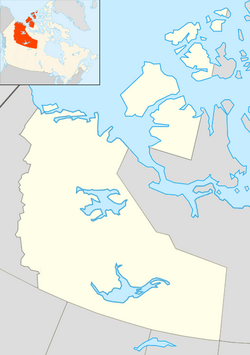Whatì facts for kids
Quick facts for kids
Whatì
Wha Tì
Tsõtì
Mïne Kö Golàa |
||
|---|---|---|
|
First Nation
|
||
 |
||
|
||
| Country | Canada | |
| Territory | Northwest Territories | |
| Region | North Slave | |
| Constituency | Monfwi | |
| North West Company trading post | 1793 | |
| Incorporated | August 4, 2005 | |
| Area | ||
| • Land | 59.95 km2 (23.15 sq mi) | |
| Elevation | 269 m (883 ft) | |
| Population
(2016)
|
||
| • Total | 470 | |
| • Density | 7.8/km2 (20/sq mi) | |
| Time zone | UTC−07:00 (MST) | |
| • Summer (DST) | UTC−06:00 (MDT) | |
| Canadian Postal code |
X0E 1P0
|
|
| Area code(s) | 867 | |
| Telephone exchange | 573 | |
| - Living cost | 152.5 | |
| - Food price index | 145.7 | |
| Sources: Department of Municipal and Community Affairs, Prince of Wales Northern Heritage Centre, Canada Flight Supplement 2013 figure based on Edmonton = 100 2015 figure based on Yellowknife = 100 |
||
Whatì (pronounced "WHA-tee") is a special community in the Northwest Territories, Canada. Its name comes from the Dogrib language and means "Marten Lakes." Whatì is officially known as the Tłı̨chǫ Community Government of Whatì. It is a First Nations community located by Lac La Martre. This spot is about 164 kilometers (102 miles) northwest of Yellowknife, which is the capital city of the territory.
Contents
History of Whatì
The area around Whatì has always been rich in wildlife. Because of this, it was a favorite hunting ground for the Tłı̨chǫ (Dogrib Dene) Indigenous people for a very long time.
Early Trading Post
In 1793, a company called the North West Company set up a trading post here. A trading post was a place where people could trade goods like furs for supplies. Many Indigenous people started to live here permanently, even though they continued to hunt and fish in the area.
Later, in the late 1800s, another trading post was built at Fort Rae. This new post was on Great Slave Lake. Most of the trading in the region then moved to Fort Rae, where the Hudson's Bay Company and other traders were located. It wasn't until the 1920s that another trading post was opened at Lac La Martre.
Name Changes and Governance
On January 1, 1996, the community changed its name from Lac La Martre to "Wha Ti." This is a Tłı̨chǫ name that also means "Marten Lake." Then, on August 4, 2005, the spelling was changed to the current "Whatì." Other old Tłı̨chǫ names for the settlement include Tsoti, meaning 'fouled water lake,' and Mine Go Kola, meaning 'net fishing with houses.'
Before 2005, Whatì was managed by a First Nations group called the Wha Ti First Nation. This group was like a local government. But in 2005, a new agreement called the Tłı̨chǫ Agreement was made. Most of the responsibilities of the Wha Ti First Nation were then given to the new Whatì Community Government. However, the federal government still recognizes the First Nation for official purposes.
Population of Whatì
In 2021, a count of the population was done by Statistics Canada. Whatì had 543 people living there. This was an increase from 470 people in 2016. The community has a land area of about 58.33 square kilometers (22.52 square miles).
Most of the people living in Whatì are Indigenous. In 2021, 445 people were First Nations and 10 were Métis. The main languages spoken in Whatì are Dogrib and English. A few people also speak North Slavey.
Economy and Activities
Hunting, trapping, and fishing are still very important ways of life in Whatì. These activities are part of the community's traditions.
Tourism and Wildlife
Efforts have also been made to grow tourism in Whatì. A fishing lodge was opened to welcome visitors. Many tourists come to see the amazing wildlife in the area. This includes animals like black bears, barren-ground caribou, wolves, and eagles.
Whatì is also part of the Tlicho Government. This is a self-governing body for the Tłı̨chǫ people.
Community Infrastructure
Transportation
For a long time, Whatì could be reached by the Whatì Airport. There was also a special winter road that could only be used when the ground was frozen. In 2019, construction began on the Tłı̨chǫ Highway. This new highway connects Whatì to the main Yellowknife Highway. The road was officially opened in November 2021, making it easier to travel to and from the community.
Communication Services
Telephone service was first brought to Whatì in 1982. This helped the community connect with the rest of the world.
Climate in Whatì
Whatì has a subarctic climate. This means it has mild to warm summers. However, the winters are very long and very cold.




